CGC Average Market Capitalization (CGCAMC): An Introduction
When the headlines say, “COMIC BOOK SELLS FOR OVER $3,000,000!” it is certainly an attention-grabber. It is not hard to name the most valuable comic books of all. Do those highest priced comic books truly represent the most total market value for an issue? Would it be better to have 2 copies of a comic worth $100,000 each or 50 copies of a comic worth $5,000 apiece?
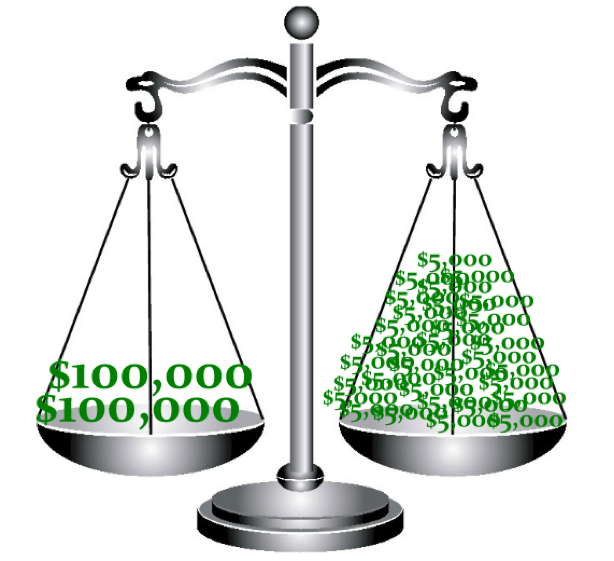
The total market for a comic is not just the price of a single copy, but the total value of all copies.
Consider the stock market, where ABC Company may have stock trading at $1,000 per share and XYZ Company may have stock trading at $100 per share. Should anyone conclude that ABC Company is ten times larger than XYZ Company? While some might think stock prices work that way, there is actually no way to make any conclusions about the size of the two companies until we determine how many shares exist for each company and include that number in the calculation.
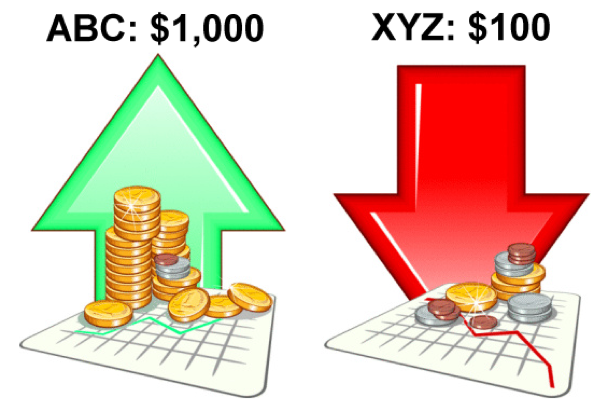
If there are 50,000 shares of ABC Company at $1,000 per share, the total value of ABC Company is $50,000,000. If there are 1,000,000 shares of XYZ Company at $100 per share, the total value of XYZ Company is $100,000,000. XYZ is the larger company, having twice the total value of ABC Company, despite the fact that one share of ABC is $1,000 and one share of XYZ is $100. This total value calculation is called market capitalization, or “market cap”.
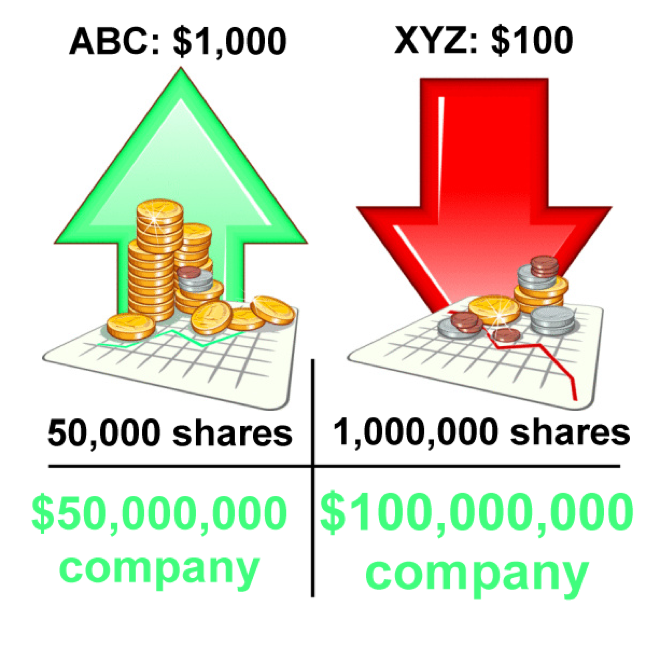
Market cap (total market value) is the calculation used to compare the sizes of any two companies. The comparison of just one share price to another does not provide much information at all.
Much attention is placed upon comic books which sell for $100,000 or more, yet there may only be 10 CGC graded copies. Very little attention may be given to comic books which sell for $400, even though there could be 5,000 CGC graded copies. Applying the market capitalization concept, the 10 CGC graded copies at $100,000 each would represent a comic book with $1,000,000 total value in the market, while the 5,000 CGC graded copies at $400 each would represent a comic book with $2,000,000 total value in the market. For just these two comics, it is the $400 comic book which would hold two-thirds of the total market value (market cap) for the two books.
The focus upon $100,000+ comic books as attention-grabbers and representatives for the overall comic market may be misplaced, and the dismissal of the $400 comic book as less worthy of attention may be quite shortsighted. The market cap concept for comics could possibly be quite useful in understanding the market, beyond any single sale price.
In practice, the market cap is not so easy to calculate. There is no way to determine how many shares (copies) of each comic exist. The exact number of copies originally printed is rarely known, and as time passes, fewer copies survive. This is a problem for the comic book market cap concept, but not the end of the discussion. Comic books are continuously graded, certified, and counted by CGC for over 20 years, providing the number of copies in the CGC Census. As of mid-2020, there were 204,534 individual comics with 5,219,783 copies graded on the CGC Census. Perhaps most importantly, these CGC Census numbers for each comic book are available to the public, so the application of the market cap concept does not need involve any hidden calculations or insider knowledge.
GPAnalysis.com provides continuing sales records for CGC graded comic books, allowing a calculation for the average market price from the most recent sales. The market cap concept is not impossible to estimate for a significant portion of the (certified) comic book market, using the CGC Census and GPAnalysis sales.
The higher the value of a comic book, the more likely it will be submitted to CGC before a sale. It has been estimated by multiple retailers that up to half (and perhaps more) of all existing copies of the highest individual value books like Action Comics #1 and Detective Comics #27 are already represented on the CGC Census. For comics of lower values, CGC grading is still very common for many comics, especially for copies in the highest surviving conditions. The CGC Census does not represent every existing copy of a comic book, but the CGC graded market does represent a significant portion of the total value of high profile comic books in the market.
The surviving copies which have been CGC graded are not all equal in the way that each share of a company is the same. There are 24 possible universal CGC grades from CGC 0.5 to CGC 10, with differing market values for each grade. It would be possible, but quite complicated, to calculate the approximate market cap for all 24 universal CGC grades, then to total the market cap for each grade using the CGC Census. Unfortunately, many CGC grades have very few GPAnalysis sales records, and values are often quite volatile at the highest end of the CGC grading scale.
To simplify and standardize an approach to a market capitalization for comic books, the market price for the average CGC universal grade for a comic can be used instead of all 24 prices for the universal CGC grades. Supposing the average CGC universal grade for a particular comic is 6.7, it would be a simple matter to review GPAnalysis recorded sales for CGC 6.5 and CGC 7.0 and calculate a single market value estimate for the 6.7 average.
Because this market cap concept is being more narrowly focused upon the CGC Census and the GPAnalysis average price for the average CGC grade, this calculation can be referenced as CGCAMC (CGC Average Market Capitalization), and the calculation for CGCAMC will be N (Number of CGC graded copies) multiplied by P (Price for average CGC grade according to GPAnalysis).
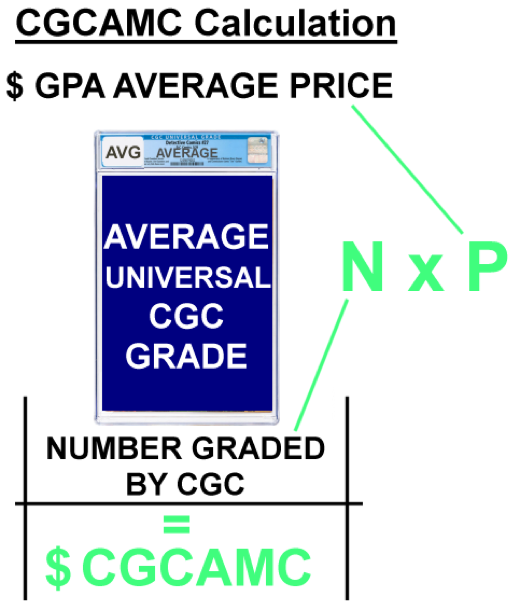
CGCAMC = N x P does not provide the total value of all existing copies of a comic book, but it is a calculation which can be useful when comparing comic books to each other in the way that two companies are compared using market capitalization.

Attempting all possible CGCAMC calculations for over 200,000 comic books on the CGC Census could take years, and the results would be constantly changing, so it is best to choose a starting point that already has the attention of the comic industry. There are three comic books considered by many to be the “Big Three” for the comic book market for their first appearances of Superman, Batman, and Spider-Man. Starting the CGCAMC calculations with the “Big Three” books should establish a comparison that many will find interesting.
The N values (Number of CGC graded copies) in the CMCAMC = N x P calculation for the “Big Three”:
Action Comics #1 (1938) = 72 copies on the CGC Census, with an average universal grade of 4.10.
Detective Comics #27 (1939) = 69 copies on the CGC Census, with an average universal grade of 4.86.
Amazing Fantasy #15 (1962) = 3,340 copies on the CGC Census, with an average universal grade of 3.52.
For the CGCAMC values of P (Price for average CGC grade according to GPAnalysis),
GPAnalysis records the most recent CGC 4.0 Action Comics #1 sale at $573,600 in May 2018, use $590,000 as the P value for Action Comics #1 CGC 4.10 average.
GPAnalysis records the most recent CGC 5.0 Detective Comics #27 sale at $569,274 in March 2018, use $555,000 as the P value for Detective Comics #27 CGC 4.86 average.
GPAnalysis records multiple sales of CGC 3.5 Amazing Fantasy #15 in mid-2020, use $18,400 as the P value for Amazing Fantasy #15 CGC 3.52 average.
CGCAMC (N x P) calculations for the “Big Three” comics, as of mid-2020:
Action Comics #1 (1938) – 72 copies multiplied by $590,000 (CGC 4.10 average) = $42,480,000
Detective Comics #27 (1939) – 69 copies multiplied by $555,000 (CGC 4.86 average) = $38,295,000
Amazing Fantasy #15 (1962) – 3,340 copies multiplied by $18,400 (CGC 3.52 average) = $61,456,000
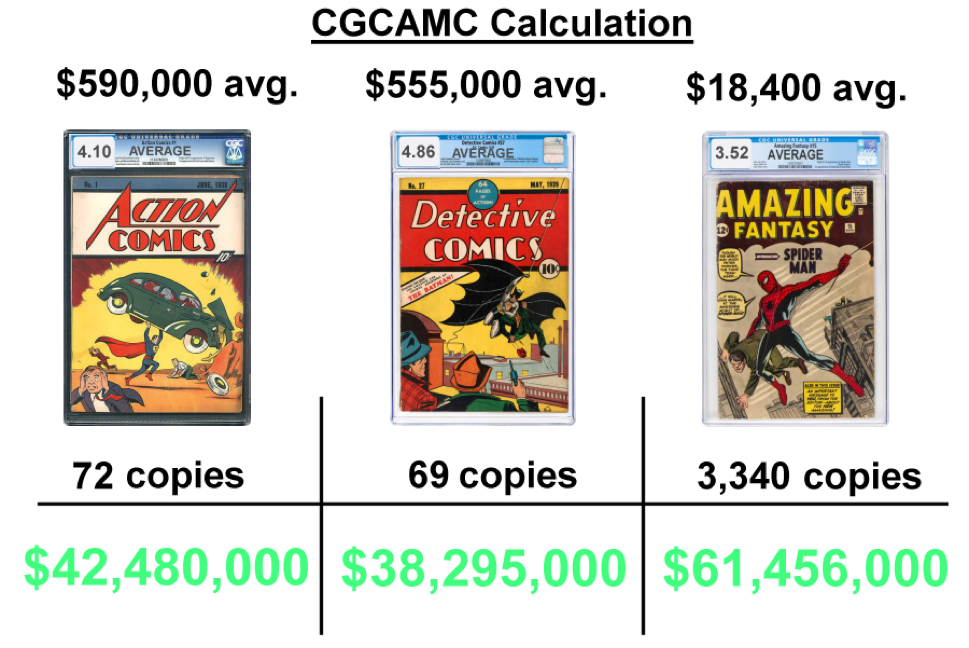
Each sale of average copies of Action Comics #1 or Detective Comics #27 draws attention with prices above $500,000. Much less attention (if any) is given for the sale of an average copy of Amazing Fantasy #15 at a price of $20,300. However, the number of CGC graded copies of Amazing Fantasy #15 multiplied by the price of an average graded copy exceeds the same calculation for both Action Comics #1 and Detective Comics #27.
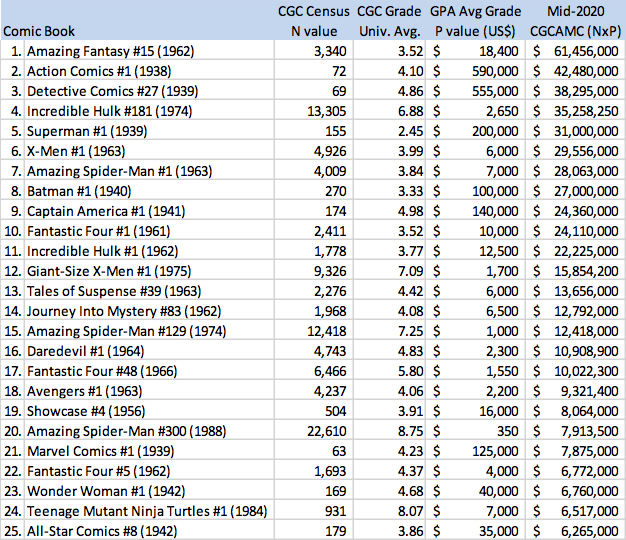
These 25 books represented the highest CGCAMC values known as of mid-2020. It’s likely that a review of these numbers at year’s end will see a shift in CGCAMC values for books like Teenage Mutant Ninja Turtles #1 (first printing), moving it higher in the Top 25 list. Books just outside the Top 25 at mid-year may overtake positions in the Top 25 at year’s end. The Top 25 CGCAMC values span fifty years from 1938 to 1988, showing that the Golden Age may always dominate individual sale prices, but any era has the potential to reach the “biggest book” lists when it comes to the CGCAMC calculation of the market.
As mentioned earlier, there are limitations and caveats to this type of calculation – potentially too many to list in any one article – but the results are straight-forward and informative in a way that few measures can be. Multiplying just two values which each have their own shortcomings may be seen as compounding the errors, however, there’s no doubt that the “Big Three” books remain the same, and the other books are shown in their respective CGCAMC values relative to those “Big Three”.
In the next article of this series, historical CGCAMC values will be explored, including the answer to “Has Amazing Fantasy #15 always had the highest total value in CGCAMC?” (Spoiler Answer: No - Amazing Fantasy #15 had the 3rd highest CGCAMC in 2015.)
About the Author
 |
Greg Holland has collected comic books for over 30 years and has been the administrator of the CGC Census Analysis website since 2003, currently located at CGCdata.com. He is the 1999 founder of the ValiantComics.com website and the 2004 ValiantFans.com message board. Dr. Holland holds a Ph.D. in information quality from the University of Arkansas at Little Rock and has held data science positions as research director, analyst, and administrator for government, corporations, and university. Active on the CGC Forums as ‘valiantman’ since 2002, he is also a 15+ year advisor to the Overstreet Comic Book Price Guide and contributor to later editions of the Standard Catalog of Comic Books. Greg resides in Arkansas, USA, with his wife of 23 years and their daughter. |
Related news
24 Oct 2022
Canadian Price Variants (CPVs) and GPAnalysis.com Recorded Sales
With Canadian Price Variants recorded in GPAnalysis.com for decades, what can the data tell us about rarity and value when comparing against direct editions?
Read more26 May 2022
CGC Census - A Game for the Thousandth Collector
Imagine a game where 1,000 lucky comic collectors are awarded the best available copies of comic books from the CGC Census. Where would ticket #1,000 be for the earliest appearances of favorite characters? Some winning books may surprise you.
Read more